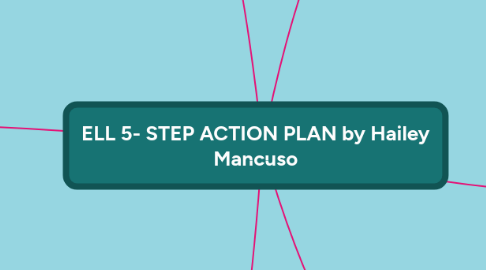
1. Step 1: Make Your Classroom Welcoming & Approachable
1.1. Who - Teachers
1.2. What - Make the classroom feel like a safe place for the ELL to come. Make yourself available for help and be sure the ELL knows you are friendly and approachable
1.3. When - From the very first time the ELL meets you and sees your classroom
1.4. Where - Inside and outside the classroom
1.5. Why - Before learning may happen, a student must feel like they are in an environment that they can be successful and comfortable working in.
1.6. How - Put many pictures on the walls that supplement textual information, use colorful and inviting colors, keep a smile on your face, encourage students to familiarize themselves with each other
2. Backrgound Information
2.1. Mexican & Korean Speakers
2.1.1. • Mexico and South Korea are considered collectivistic societies. Family and loyalty in a collectivist culture is key, and comes before most other societal rules. These countries value strong relationships where everyone takes responsibility for fellow members of their group. • Both countries have a hierarchical system within society. This means that people accept a hierarchical order in which everybody has a place or rank. These characteristics help me to understand how Luis and Jin are being taught to view the world. • Mexico and South Korea are both considered collectivistic societies vs. United States is an individualistic one. In Individualist societies people are only supposed to look after themselves and their direct family. This could affect students coming from collectivist societies in my classroom. If US bred students are in school believing that the only person they should be worried about is themselves, while other students are trying to pay attention to the wellbeing of their peers, their feelings might be hurt when the actions are not reciprocated. • The US also differs from these countries in the “power distance” dimension. This dimension deals with the fact that all individuals in societies are not equal – it expresses the attitude of the culture towards these inequalities amongst us. In the US, the power distance is relatively low. People do not accept that power is distributed unequally as much as the people do in Mexico and South Korea. This might cause conflict for ELL students who feel better or less than other students and make it apparent to other children.
3. Step 5: Monitor Progress & Reflect on Learning
3.1. Who - Teachers, Parents, Administration, Student
3.2. What - Keep track of how the student is progressing in all aspects of school, including social progress. Reflect on things that work very well, and things you changed throughout the year to help the student better learn
3.3. When - At the end of each lesson, unit, marking period, semester, school year, etc.
3.4. Where - In the classroom, during conferences
3.5. Why - Monitoring and reflecting are important steps for bettering your teaching strategies. You learn a lot about yourself and your students when you look back at things that worked vs. things that need improvement. This can also be a step that results in going back to the differentiating instruction step to try something new
3.6. How - Formal and informal assessments, verbal communication progress, surveys, etc.
4. Step 4: Differentiate Accordingly
4.1. Who - Teachers
4.1.1. Type
4.1.2. Topic
4.2. What - Plan well in advance how you will differentiate instruction for the ELL at every step of the lesson planning process. Always be thinking one-step ahead and planning for "what if" moments throughout lessons. Know how you will provide accommodations for ELL's and the materials you'll need to do so
4.2.1. Type
4.2.2. Topic
4.3. When - During lesson planning & actual instruction
4.4. Where - In the classroom & at home if there is homework required
4.5. Why - Lessons should never be generally blanketed over all students the same. Differentiation is necessary to meet the needs of all students - including ELLs. Personalizing student learning will accelerate the time it may take for them to learn a lesson
4.6. How - Providing extra time for assignments, clearly posting objectives in both text and audio representations, using pictures, and altering speaking habits are all examples of ways to differentiate for ELLs
5. Step 2: Learn & Acknowledge ELL's Cultural Background
5.1. Who - Teachers and Administration
5.1.1. Type
5.1.2. Topic
5.2. What - Familiarize teachers and administration with the cultural influences that are present in the school. Acknowledge that the cultures of ELL's are equally as important and may be recognized school-wide
5.2.1. Type
5.2.2. Topic
5.3. When - After meeting the ELL and seeing if they are comfortable disclosing information about their culture, ideally in the first few weeks of school
5.4. Where - By emailing parents or doing personal research at home
5.5. Why - Blindly trying to teach ELL's without any information about how their cultural background will influence the reception of information will be almost impossible. It is vital to do this both to help teachers teach in the way that is best for students, and to make the student feel important and valued
5.6. How - If the student is comfortable with it, have them give a brief presentation of the highlights within their culture. Perhaps bring in art, music, food, or anything the ELL feels comfortable showing. An instance of this could be a Korean student beginning the week by bringing in a Korean delicacy, then continuing an entire "Korean Week," where the particular student can feel like a leader.
6. Step 3: Become Involved
6.1. Who - Teachers, administration, parents, student
6.1.1. Type
6.1.2. Topic
6.2. What - Keep open lines of communication between teachers, parents, administration and the student to update and inform one another of any relevant information. Become involved in helping the student and setting them up for success
6.2.1. Type
6.2.2. Topic
